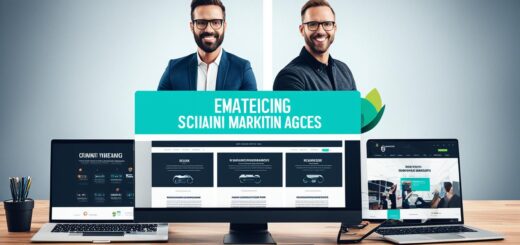Developing a Winning Digital Strategy
Are you looking to develop a winning digital strategy? Look no further! In this article, we will provide you with a comprehensive overview of various aspects of digital marketing that can help you achieve your goals. From search engine optimization (SEO) to social media marketing, content marketing to email marketing, e-commerce marketing to influencer marketing, we’ve got you covered. Learn about the different strategies, tools, and best practices that can take your digital presence to the next level. So, let’s dive right in and explore the world of digital marketing together!

Search Engine Optimization (SEO)
Search Engine Optimization (SEO) is a crucial aspect of digital marketing that aims to improve the visibility and ranking of a website on search engine results pages. By optimizing various elements both on and off the website, SEO helps attract organic, high-quality traffic and increases the chances of converting visitors into customers.
On-page SEO
On-page SEO refers to the optimization techniques that are directly implemented on a website to improve its search engine ranking. This includes optimizing meta tags, URL structures, headings, keyword usage, image alt tags, and internal linking. On-page SEO also involves creating high-quality and relevant content that aligns with users’ search intent.
Off-page SEO
Off-page SEO, on the other hand, focuses on improving a website’s credibility and authority through external factors. This includes building backlinks from reputable websites, social media sharing, guest blogging, and online directory listings. Off-page SEO helps search engines recognize the website as a reliable source and improves its chances of ranking higher in search results.
SEO tools
There are numerous SEO tools available to assist in optimizing websites and tracking their performance. These tools provide valuable insights on keyword research, competitor analysis, backlink monitoring, website audits, and performance tracking. Some popular SEO tools include Google Search Console, SEMrush, Moz, Ahrefs, and Yoast SEO.
Local SEO
Local SEO focuses on optimizing a website to rank higher in local search results. This is particularly important for businesses that have a physical presence or target customers in specific geographical locations. Local SEO techniques include optimizing Google My Business listings, creating location-specific landing pages, obtaining online reviews, and optimizing for local keywords.
Search Engine Marketing (SEM)
Search Engine Marketing (SEM) involves promoting a website through paid advertisements on search engine results pages. By bidding on keywords relevant to their target audience, businesses can ensure their ads appear at the top of search results, driving immediate and targeted traffic to their websites.
Google Ads
Google Ads, formerly known as Google AdWords, is the most widely used platform for SEM. It allows businesses to create text-based ads and display them on Google’s search engine results pages, Google Maps, YouTube, and other partner websites. Google Ads offers various targeting options, ad formats, and bid strategies to effectively reach the desired audience.
Bing Ads
Bing Ads is the search advertising platform owned by Microsoft, which serves ads on the Bing search engine and its partner networks, including Yahoo. While Bing has a smaller market share compared to Google, it can still provide valuable traffic and reach a different audience segment. Bing Ads offers similar targeting options to Google Ads, making it a viable addition to an SEM strategy.
Paid search advertising
Paid search advertising, also known as pay-per-click (PPC) advertising, is a SEM technique where advertisers pay a fee each time their ad is clicked. Advertisers bid on keywords relevant to their products or services and can choose from various bid strategies and ad formats. Paid search advertising provides businesses with instant visibility and control over their ad campaigns.
Ad campaign management
Ad campaign management involves strategizing, implementing, and optimizing SEM campaigns to achieve specific marketing objectives. This includes setting campaign goals, defining target audiences, selecting keywords, creating compelling ad copy, monitoring performance metrics, and adjusting bids and budgets to maximize ROI. Effective campaign management ensures that SEM efforts yield the desired results.
Social Media Marketing
Social Media Marketing utilizes various social media platforms to connect with audiences, build brand awareness, and drive engagement. By creating and sharing relevant content, businesses can establish relationships with their target market and leverage social media’s extensive user base for effective marketing campaigns.
Facebook marketing
Facebook is the largest social media platform, with billions of active users. Facebook marketing involves creating a business page, sharing engaging content, interacting with followers, and utilizing paid advertising options, such as Facebook Ads. Facebook provides detailed targeting capabilities, allowing businesses to reach specific demographics, interests, and behaviors.
Instagram advertising
Instagram is a highly visual platform that focuses on sharing photos and videos. Instagram advertising allows businesses to create visually appealing ads and target specific demographics or interests. With features like Instagram Stories and shoppable posts, businesses can effectively showcase products and drive traffic to their websites.
Twitter promotion
Twitter is a real-time microblogging platform that allows businesses to engage with their customers through short messages called tweets. Twitter promotion involves sharing updates, industry news, and engaging with followers to build brand awareness and customer loyalty. Twitter also offers paid advertising options, including promoted tweets and accounts, to reach a wider audience.
LinkedIn marketing strategy
LinkedIn is a professional networking platform that caters to businesses and professionals. A LinkedIn marketing strategy involves creating a strong business profile, sharing industry-specific content, engaging with relevant groups, and utilizing LinkedIn’s advertising options. LinkedIn provides unique targeting options, allowing businesses to reach professionals based on their job titles, industries, and interests.
Content Marketing
Content Marketing focuses on creating and distributing valuable and relevant content to attract and engage a defined target audience. By providing informative and entertaining content, businesses can establish themselves as authorities in their industry and build trust with their audience.
Blog content strategy
A blog content strategy involves planning and creating blog posts that align with the business’s goals and target audience’s interests. This includes conducting keyword research to identify relevant topics, creating an editorial calendar, optimizing blog posts for SEO, and promoting them through various channels. A well-executed blog content strategy can drive organic traffic and generate leads.
Content creation tools
Content creation tools help streamline the process of creating high-quality and engaging content. These tools assist in brainstorming ideas, organizing content outlines, optimizing for SEO, editing and proofreading, and creating visually appealing graphics or videos. Examples of content creation tools include Grammarly, Canva, Buzzsumo, and Hemingway Editor.
Video content marketing
Video content marketing involves creating and sharing videos to promote products or services, educate the audience, or convey compelling storytelling. With the popularity of video-sharing platforms like YouTube and social media’s video features, businesses can leverage video content to increase engagement, reach a wider audience, and drive traffic to their websites.
Infographic promotion
Infographics are visually appealing representations of complex information or data. Infographic promotion involves creating visually engaging and informative infographics and sharing them through various channels, such as social media, blog posts, or email campaigns. Infographics can help simplify complex topics, increase content shareability, and attract attention from potential customers.

Email Marketing
Email Marketing is a direct and targeted approach to reach customers and potential customers through email campaigns. It allows businesses to nurture relationships, deliver personalized messages, and drive conversions by delivering relevant content directly to the inbox.
Email automation
Email automation involves setting up predetermined triggers and workflows to send specific emails based on the recipient’s actions or behaviors. This can include welcome emails, abandoned cart reminders, post-purchase follow-ups, or personalized recommendations. Automation ensures timely and relevant communication with subscribers, improving customer engagement and driving conversions.
Email campaign optimization
Optimizing email campaigns involves continuously improving email content, design, and targeting to maximize open rates, click-through rates, and conversions. This includes A/B testing subject lines, optimizing email templates for mobile devices, personalizing emails, and segmenting the subscriber list based on demographics or behaviors. By analyzing campaign metrics, businesses can refine their email marketing strategies and achieve better results.
Email marketing tools
Email marketing tools provide businesses with the necessary features to plan, execute, and analyze email campaigns effectively. These tools often include features like email design templates, automation workflows, subscriber list management, advanced analytics, and A/B testing capabilities. Popular email marketing tools include Mailchimp, Constant Contact, Sendinblue, and HubSpot Email Marketing.
Newsletter best practices
Newsletters are a powerful way to keep subscribers informed about the latest updates, content, or promotions. Newsletter best practices involve crafting compelling subject lines, providing valuable content, using engaging visuals, optimizing for mobile devices, and including clear call-to-actions. By following best practices, businesses can increase open rates, engagement, and conversions through their newsletters.
Digital Analytics
Digital Analytics is the practice of collecting, analyzing, and interpreting data from various digital marketing channels to optimize strategies and make data-driven decisions. By understanding user behavior, demographics, and preferences, businesses can measure the effectiveness of their marketing efforts and identify areas for improvement.
Google Analytics tips
Google Analytics is a powerful tool that provides detailed insights into website performance, user behavior, and conversion tracking. Understanding and implementing Google Analytics tips can help businesses extract valuable data and utilize it to improve various aspects of their digital marketing strategies. Tips may include setting up conversion goals, analyzing audience demographics, tracking traffic sources, and implementing custom tracking.
Data-driven marketing
Data-driven marketing utilizes insights and patterns derived from data analysis to optimize marketing strategies and improve campaign performance. By leveraging data from various sources, such as website analytics, customer behavior, or market research, businesses can make informed decisions, make adjustments in real-time, and achieve better ROI.
Web analytics tools
Apart from Google Analytics, there are various web analytics tools available that provide insights into website performance and user behavior. These tools may offer additional functionalities and customized reports to suit specific business needs. Some popular web analytics tools include Adobe Analytics, Piwik, Kissmetrics, and Mixpanel.
Analytics reporting
Analytics reporting involves analyzing and presenting the collected data in a format that is easily understandable and actionable. Effective reporting may include creating dashboards or visualizations, identifying key performance indicators (KPIs), tracking trends, comparing data against benchmarks, and summarizing insights to support data-driven decision making.
E-commerce Marketing
E-commerce Marketing focuses on promoting and driving sales for online stores. By utilizing various marketing strategies and tactics tailored to the e-commerce industry, businesses can increase website traffic, generate leads, and ultimately boost revenue.
Online store optimization
Online store optimization involves improving the user experience, functionality, and conversion rate of an e-commerce website. This includes optimizing product pages, simplifying the checkout process, improving site speed, implementing responsive design for mobile devices, and utilizing customer reviews and ratings. A well-optimized online store can enhance customer satisfaction and increase the likelihood of conversions.
E-commerce SEO
E-commerce SEO focuses on optimizing product pages, category pages, and other elements to improve the website’s visibility in search engine results. This includes keyword research, optimizing product descriptions, implementing schema markup, generating relevant and optimized content, and building high-quality backlinks. E-commerce SEO aims to attract targeted organic traffic and increase conversions.
Product listing ads
Product listing ads, also known as shopping ads, are a type of online advertising that showcases products directly on search engine results pages. These ads display images, prices, and other product details, making them highly visible and appealing to potential customers. Product listing ads can significantly increase click-through rates and conversions for e-commerce businesses.
Cart abandonment strategies
Cart abandonment occurs when a customer adds products to their online shopping cart but leaves the website without completing the purchase. Cart abandonment strategies focus on reducing the number of abandoned carts and recovering lost sales. This can be achieved through tactics such as offering incentives or discounts, sending abandoned cart reminder emails, simplifying the checkout process, and optimizing the website for mobile devices.
Influencer Marketing
Influencer Marketing involves partnering with influential individuals in a specific industry or niche to promote a brand, product, or service. By leveraging the reach and credibility of influencers, businesses can tap into their dedicated audiences, increase brand awareness, and drive conversions.
Influencer collaborations
Influencer collaborations involve partnering with influencers to create content, such as sponsored posts, videos, or reviews. These collaborations can help businesses reach a wider audience, gain credibility, and generate engagement. Collaborations can take various forms, such as product gifting, sponsored events, or long-term partnerships, depending on the objectives and budget of the campaign.
Influencer outreach
Influencer outreach involves identifying and establishing relationships with relevant influencers to promote a brand or product. Outreach strategies may include personalized emails, direct messages on social media, or participating in industry events where influencers are present. Building a genuine connection with influencers can lead to mutually beneficial partnerships and increase brand exposure.
Micro-influencers
Micro-influencers are individuals with a smaller, but highly engaged, social media following within a specific niche. Collaborating with micro-influencers can be advantageous for businesses that target niche markets or have a limited budget. Micro-influencers often have a more personal connection with their audience, resulting in higher engagement rates and stronger trust.
Influencer marketing platforms
Influencer marketing platforms serve as a marketplace for businesses and influencers to connect, collaborate, and manage influencer marketing campaigns. These platforms provide search and discovery tools, campaign management features, performance tracking, and payment processing. Examples of influencer marketing platforms include Upfluence, AspireIQ, Grin, and Influenster.
Mobile Marketing
Mobile Marketing encompasses various marketing strategies and tactics tailored specifically for mobile devices, such as smartphones and tablets. As mobile usage continues to rise, businesses need to optimize their marketing efforts to effectively reach and engage with mobile users.
Mobile app marketing
Mobile app marketing involves promoting and driving adoption of a mobile application. This includes optimizing app store listings, creating engaging app screenshots and videos, implementing app install campaigns, and utilizing push notifications to communicate with users. Mobile app marketing aims to increase app downloads, user engagement, and retention.
Mobile advertising
Mobile advertising encompasses various types of ads displayed within mobile apps, mobile websites, or other mobile platforms. This can include banner ads, interstitial ads, native ads, or video ads optimized for mobile devices. Mobile advertising enables businesses to reach users on the go and drive traffic to their websites or mobile applications.
Mobile SEO
Mobile SEO focuses on optimizing websites to be mobile-friendly and perform well on mobile search results. This includes implementing responsive design, optimizing page loading speed, ensuring proper mobile viewport settings, and using mobile-focused keywords. With more users accessing the internet through mobile devices, mobile SEO is critical for a successful online presence.
In-app advertising
In-app advertising involves displaying ads within mobile applications. These ads can take various forms, such as banners, videos, or native ads, and can be served based on the user’s demographic, behavior, or the content of the app. In-app advertising provides businesses with opportunities to target specific audiences and maximize reach and engagement.
Video Marketing
Video Marketing utilizes videos as a powerful medium to promote products, services, or brand messages. By creating compelling and visually engaging videos, businesses can capture their audience’s attention, evoke emotions, and effectively convey their marketing messages.
YouTube advertising
YouTube advertising allows businesses to display video ads within YouTube’s vast network of videos. These ads can appear before or during videos, as well as in YouTube search results or on related videos. Businesses can target specific demographics, interests, or keywords to reach relevant audiences and increase brand exposure.
Video SEO
Video SEO involves optimizing videos to improve their visibility and ranking in video search engine results pages. This includes optimizing video titles, descriptions, tags, and thumbnails, as well as ensuring videos are embedded correctly on websites. Video SEO helps increase organic traffic to videos and improves their chances of being discovered by the target audience.
Video content creation
Video content creation involves planning, producing, and editing videos that align with a business’s goals and audience’s preferences. This can include brand videos, product demonstrations, explainer videos, interviews, or behind-the-scenes footage. Creating high-quality and engaging videos can captivate viewers, increase brand awareness, and drive user engagement.
Live video promotion
Live video promotion involves streaming live videos on social media platforms or dedicated live streaming platforms, such as Facebook Live or Twitch. Live videos provide businesses with an opportunity to interact with their audience in real-time, answer questions, showcase products, or host events. Live video promotion can create a sense of authenticity and encourage audience engagement.
In conclusion, a comprehensive digital marketing strategy encompasses various aspects, including search engine optimization (SEO), search engine marketing (SEM), social media marketing, content marketing, email marketing, digital analytics, e-commerce marketing, influencer marketing, mobile marketing, and video marketing. By utilizing these strategies effectively, businesses can reach their target audience, boost brand visibility, drive conversion, and stay ahead in the digital landscape. Remember to analyze data, stay up to date with the latest trends, and continuously optimize your marketing efforts to achieve optimal results.
















It's great that you talked about how business insurance can provide financial protection against unexpected events and help ensure the…
I like that you mentioned how business insurance is essential for protecting your bottom line and the long-term viability of…